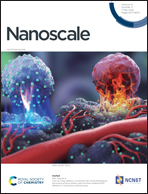On-chip high ion sensitivity electrochromic nanophotonic light modulator†
Abstract
Since the discovery of electrochromism, the prospect of employing various electrochromic materials for smart window glass, variable reflectivity mirrors, and large-area displays has been the main drive for such an intriguing phenomenon. However, with advances in nanofabrication and the emergence of improved electrochromic materials offering reversible large changes in dielectric properties upon electrically induced redox reactions, the application strategies are starting to encompass the field of nanophotonics and nanoplasmonics. Herein, a novel strategy is proposed and demonstrated for offering both ultrahigh light modulation depth and high sensitivity ion detection in a single nanophotonic waveguiding platform. By using WO3 to ionically-drive dynamic light control via modulating the refractive index and the losses within the waveguide at ±1.5 V, ultrahigh optical modulation depth of 106, rapid response speed of <0.56 s, long cyclic life, and very sensitive Na+ ion detection ability in 1 mM–1 M concentration, are achieved within a volume of a few μm3. It is envisioned that our introduction of such a multifunctional electrochromic nanophotonic waveguide platform will stimulate and promote further efforts toward fundamental research on technologically promising on-chip integrated next-generation nanophotonic and nanoplasmonic devices for various niche applications.



 Please wait while we load your content...
Please wait while we load your content...